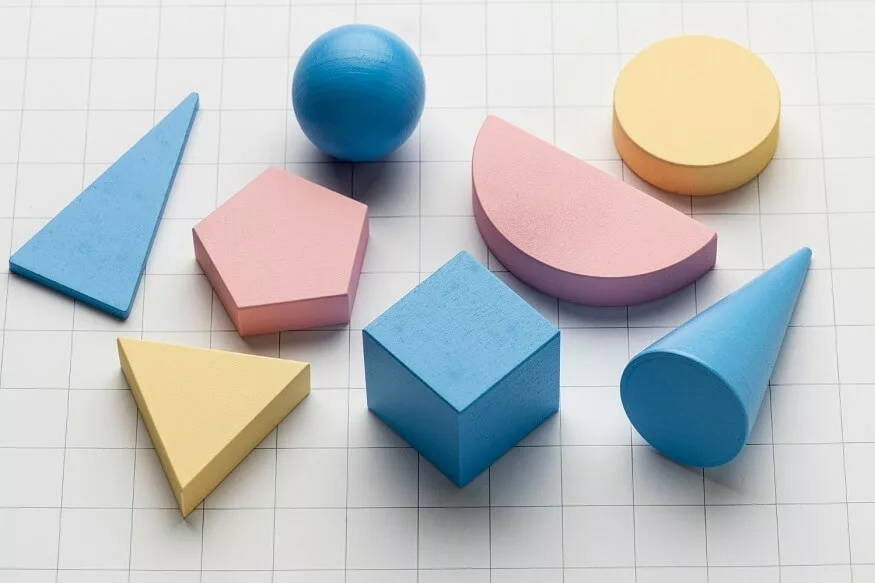Beyond the mathematical intricacies, areas and volumes hold lesser-known, practical significance that often goes unnoticed. Geometry, typically regarded as a school subject, plays a crucial role in comprehending the world of shapes and space in our everyday experiences. In this article, we aim to shine a light on these concealed aspects of geometry by exploring the calculations of areas and volumes in the realms of 2D and 3D shapes. As we journey through this exploration, you’ll gain the knowledge to unveil the space within a cylinder, decipher the volume of a sphere, and effortlessly calculate the area of a circle.
Also Read: What are Flashcards, and how to use them?
Understanding 2D Shapes: Navigating Flat Geometry
In the realm of 2D shapes, we’re dealing with flat, two-dimensional figures that are like puzzle pieces in the world of geometry. These shapes are the foundation for understanding more complex geometric concepts. It’s not as daunting as it sounds; in fact, it’s all about mastering the basics.
The Basics of 2D Shapes
Simply put, 2D shapes are shapes that exist on a flat surface, like a painting on paper. Even if they take different shapes, they are all related by the process of calculating their areas. The most fundamental 2D shape is the circle.
Calculating Areas in 2D Shapes
When we discuss determining the “area” of a shape, we are essentially attempting to ascertain the extent of space it encompasses within its confines. In the context of 2D shapes, this involves identifying the area inside the shape, a skill that proves particularly useful in practical, real-world scenarios.
The Circle: Calculating its Area
Circles are a common 2D shape found in everyday objects like bicycle wheels and plates. Calculating a circle’s area is straightforward: use the formula Area = πr², where ‘r’ is the radius. Simply square the radius and multiply it by π (around 3.14159) to find the area. It may seem mathematical, but it’s quite manageable.
Triangles, Rectangles, and Squares: Common 2D Shapes
Beyond circles, we have other basic 2D shapes that are equally important. These include triangles, rectangles, and squares. These shapes are everywhere in our daily lives, and knowing how to calculate their areas can be incredibly practical.
For triangles, the area is calculated using the formula: Area = (1/2) * base * height. When it comes to rectangles and squares, the formula is simpler: Area = length * width.
More Complex 2D Shapes
Not all 2D shapes exhibit the simplicity of circles or basic polygons. Some shapes possess a bit more intricacy, but they can invariably be deconstructed into more elementary components. Consider calculating the area of a trapezium, for instance. It is divided into two triangles and a rectangle, and the areas of each are found by adding them together to determine the overall area.
Also Read: How playfulness develops and spurs a drive to learn
2D and 3D Shapes: A Seamless Connection
While we’re discussing 2D shapes, it’s essential to recognize their connection to 3D shapes. Many 3D shapes have 2D shapes as their bases or faces. The two-dimensional foundations are fundamental when calculating the areas and volumes of these three-dimensional shapes.
Exploring the Depth of 3D Shapes
Now, let’s venture into the fascinating world of 3D shapes. These objects exist in three dimensions, adding depth and substance to the world of geometry. When dealing with 3D shapes, our focus shifts from calculating areas to determining volumes.
From 2D to 3D conversion
From 2D to 3D geometry represents a shift towards a deeper understanding of shapes. This move from flat to three-dimensional shapes is more approachable than it may appear, and it opens up a fresh array of practical uses.
Also Read: Ways to Build and Expand Your Child’s Vocabulary
Introducing 3D Shapes
In the world of 3D geometry, you’ll encounter an array of intriguing shapes that have depth and volume. Three essential 3D shapes that we’ll explore in detail are cylinders, spheres, and prisms.
Calculating Volumes in 3D Shapes
In the realm of 3D shapes, the game changes from calculating areas to determining volumes. Volume is all about understanding the space a 3D shape occupies in three dimensions, like measuring the capacity of a soda can or the space inside a soccer ball.
Cylinders: Calculating their Volume
Cylinders are a frequent sight in your daily routines, from soda cans to pillars; they both take on a cylindrical shape. To determine the volume of a cylinder, you’ll need to account for both the circular base and its height. Calculating the cylinder’s volume is a simple task, with the formula as follows: Volume = πr²h. In this equation, ‘r’ denotes the radius of the base, while ‘h’ signifies the height of the cylinder. The connection to 2D shapes is evident here. The base of a cylinder is a circle, highlighting the importance of understanding the area of circles when determining the volume of cylinders.
Also Read: Parents know best How you can play and learn at the same time
Spheres: Calculating their Volume
Spheres are unique 3D shapes with perfectly round surfaces, much like the Earth or a ball. Calculating the volume of a sphere is straightforward, and it’s a useful skill, whether you’re dealing with sports equipment or contemplating the size of our planet.
The formula for finding the volume of a sphere is Volume = (4/3) πr³, with ‘r’ representing the radius. To calculate the volume, simply cube the radius, multiply it by the constant π, and then by 4/3.
Practical Applications of Geometry
Understanding how to calculate areas and volumes in 2D and 3D shapes goes far beyond the classroom. It’s a skill with real-world applications, helping us solve everyday problems and make informed decisions.
Geometry Beyond the Classroom
While we often encounter geometry as a subject within the confines of a classroom, its principles extend far beyond academic walls. Geometry is the silent force guiding our interactions with the physical world.
Also Read: Creating effective environments for learning reflection through play
Painting a Room: Calculating Wall Area
Imagine you’re a homeowner preparing to paint a room. You want to make sure you purchase the right amount of paint. This task involves calculating the area of the room’s walls, which are usually rectangular. Understanding how to find the area of these shapes becomes essential.
Farmers and Cylindrical Tanks: Determining Volume
In agricultural settings, geometry plays a practical role. Consider a farmer who needs to assess the capacity of a cylindrical tank used for storing water, grains, or other materials. Their ability to compute the tank’s volume will allow them to make well-informed decisions regarding distribution and storage.
Geometry is not just a subject; it’s a vital instrument that helps us make decisions and get around in the outer world. These ideas apply to everyone, regardless of status: professionals, students, or just shape enthusiasts. The usefulness of geometry adds to its beauty in addition to its elegance. These calculations, often learned in classrooms, become essential tools for everyday decisions. Geometry silently guides us in making sense of the world. The next time you encounter a 2D or 3D shape, remember that you know to calculate its area or volume. Geometry isn’t just a school subject; it’s a universal language for understanding our three-dimensional world.
EuroSchool‘s curriculum empowers students with practical knowledge, and one of the essential components is understanding areas and volumes in the realm of 2D and 3D shapes. From mastering the art of calculating circle areas to unlocking the secrets of cylinders and spheres, EuroSchool offers a comprehensive education in geometry. This education extends beyond the classroom, equipping students with skills they can apply in real-life scenarios, whether it’s determining the area of a room for painting or assessing the volume of a cylindrical tank for various agricultural purposes. At EuroSchool, we believe that understanding the practical applications of geometry is a valuable skill that prepares students to navigate and succeed in the world around them.











